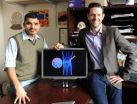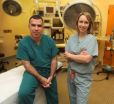(Press-News.org) Boston, MA - Some 25 million people in the United States alone suffer from rheumatoid arthritis or its cousin osteoarthritis, diseases characterized by often debilitating pain in the joints. Now researchers at Brigham and Women's Hospital (BWH) report an injectable gel that could spell the future for treating these diseases and others.
Among its advantages, the gel could allow the targeted release of medicine at an affected joint, and could dispense that medicine on demand in response to enzymes associated with arthritic flare-ups.
"We think that this platform could be useful for multiple medical applications including the localized treatment of cancer, ocular disease, and cardiovascular disease," said Jeffrey Karp, leader of the research and co-director of the Center for Regenerative Therapeutics at BWH.
Karp will present the findings April 15 at the annual meeting of the Society for Biomaterials (SFB) as part of winning the coveted SFB Young Investigator Award for this work. The work was also reported by Karp and colleagues in the May 2011 issue of the Journal of Biomedical Materials Research (JBMR): Part A, and is currently available on the journal's website.
Local Delivery
Arthritis is a good example of a disease that attacks specific parts of the body. Conventional treatments for it, however, largely involve drugs taken orally. Not only do these take a while (often weeks) to exert their effects, they can have additional side effects. That is because the drug is dispersed throughout the body, not just at the affected joint. Further, high concentrations of the drug are necessary to deliver enough to the affected joint, which runs the risk of toxicity.
"There are many instances where we would like to deliver drugs to a specific location, but it's very challenging to do so without encountering major barriers," says Karp, who also holds appointments through Harvard Medical School (HMS), Harvard Stem Cell Institute (HSCI), and the Harvard-MIT Division of Health Sciences and Technology (HST).
For example, you could inject a drug into the target area, but it won't last long--only minutes to hours--because it is removed by the body's highly efficient lymphatic system. What about implantable drug-delivery devices? Most of these are composed of stiff materials that in a dynamic environment like a joint can rub and cause inflammation on their own. Further, most of these devices release medicine continuously--even when it's not needed. Arthritis, for example, occurs in cycles characterized by flare-ups then remission.
Toward the Holy Grail
"The Holy Grail of drug delivery is an autonomous system that [meters] the amount of drug released in response to a biological stimulus, ensuring that the drug is released only when needed at a therapeutically relevant concentration," Karp and colleagues write in JBMR. His coauthors are Praveen Kumar Vemula, Nathaniel Campbell, and Abdullah Syed of BWH, HMS and HSCI; Eric Boilard (now at Université Laval), Melaku Muluneh, and David Weitz of Harvard University; and David Lee of BWH, currently at Novartis. Karp notes the key involvement of Lee, a doctor who is "treating patients with the problem we're trying to solve."
The researchers tackled the problem by first determining the key criteria for a successful locally administered arthritis treatment. In addition to having the ability to release drug on demand, for example, the delivery vehicle should be injectable through a small needle and allow high concentrations of the drug. The team ultimately determined that an injectable gel seemed most promising.
Next step: what would the gel be made of? To cut the time involved in bringing a new technology to market, the team focused only on materials already designated by the Food and Drug Administration as being generally recognized as safe (GRAS) for use in humans.
Ultimately, they discovered a GRAS material that could be coaxed into self-assembling into a drug-containing gel. "The beauty of self-assembly is that whatever exists in solution during the assembly process--in this case, a drug--becomes entrapped," says Vemula, first author of the paper, who also has an appointment at HST.
They further expected that the same material would disassemble, releasing its drug payload, when exposed to the enzymes present during inflammations like those associated with arthritis.
Promising Results
A series of experiments confirmed this. For example, the team created a gel containing a dye as a stand-in for a drug, then exposed it to enzymes associated with arthritis. The drug was released. Further, the addition of agents that inhibited the enzymes stopped the release, indicating that the gel "can release encapsulated agents in an on-demand manner," the researchers write. Although the team has yet to test this in humans, they did find that dye was also released in response to synovial fluid taken from arthritic human joints.
Among other promising results, the researchers found that gel injected into the healthy joints of mice remained stable for at least two months. Further, the gel withstood wear and tear representative of conditions in a moving joint.
Additional tests in mice are underway. The technique has yet to be demonstrated in humans, but the researchers write that it "should have broad implications for the localized treatment of many…diseases" caused by the enzymatic destruction of tissues.
The researchers have applied for a patent on the work, which was sponsored by the Center for Integration of Medicine and Innovative Technology (CIMIT) through the U.S. Army and by the Harvard Catalyst Program.
INFORMATION:
Brigham and Women's Hospital (BWH) is a 793-bed nonprofit teaching affiliate of Harvard Medical School and a founding member of Partners HealthCare, an integrated health care delivery network. BWH is the home of the Carl J. and Ruth Shapiro Cardiovascular Center, the most advanced center of its kind. BWH is committed to excellence in patient care with expertise in virtually every specialty of medicine and surgery. The BWH medical preeminence dates back to 1832, and today that rich history in clinical care is coupled with its national leadership in quality improvement and patient safety initiatives and its dedication to educating and training the next generation of health care professionals. Through investigation and discovery conducted at its Biomedical Research Institute (BRI), BWH is an international leader in basic, clinical and translational research on human diseases, involving more than 900 physician-investigators and renowned biomedical scientists and faculty supported by more than $ 537 M in funding. BWH is also home to major landmark epidemiologic population studies, including the Nurses' and Physicians' Health Studies and the Women's Health Initiative. For more information about BWH, please visit www.brighamandwomens.org.
Injectable gel could spell relief for arthritis sufferers
Researchers at BWH create an injectable gel that could spell the future for treating arthritis
2011-04-14
ELSE PRESS RELEASES FROM THIS DATE:
Medical Malpractice: Limiting Damages vs. Addressing Errors
2011-04-14
President Obama recently acknowledged he is willing to contemplate reforms to the medical malpractice structure and look at options other than the repeal of his health care bill to bring down health care costs. He has placed medical malpractice reforms on the table in order to "rein in frivolous lawsuits," says the LA Times. Previously, House Republicans proposed legislation with a $250,000 cap on pain and suffering damages caused by "any health care goods or services or any medical product."
Damage Caps vs. Addressing Medical Errors
Many patients' rights advocates ...
Ultra-fast magnetic reversal observed
2011-04-14
A newly discovered magnetic phenomenon could accelerate data storage by several orders of magnitude.
With a constantly growing flood of information, we are being inundated with increasing quantities of data, which we in turn want to process faster than ever. Oddly, the physical limit to the recording speed of magnetic storage media has remained largely unresearched. In experiments performed on the particle accelerator BESSY II of Helmholtz-Zentrum Berlin, Dutch researchers have now achieved ultrafast magnetic reversal and discovered a surprising phenomenon.
In magnetic ...
Improvements in embryonic preimplantation genetic screening techniques
2011-04-14
A Short Comparative Genomic Hybridisation (CGH) method has been developed to carry out preimplantation genetic screening (PGS) by analysing all chromosomes and transferring selected embryos to the recipient uterus in the same in vitro fertilisation cycle. This eliminates the need to freeze them.
The technique has been applied to the screening of chromosomal anomalies in cases of advanced maternal age, recurrent miscarriages or repeated implantation failures.
Short-CGH achieved, as part of a PGS programme, the pregnancy of a woman whose partner is carrier of two chromosomal ...
New Technology Promises a Brighter Future for Spinal Cord Injury Victims
2011-04-14
The most serious consequences of a motor vehicle accident, construction accident or other traumatic event can leave a family facing steep financial challenges. Traumatic brain injuries, horrific burns or other catastrophic injuries can require a lifetime of expensive medical treatment and lost income.
One common result of the violent forces that accompany a serious accident is a spinal cord injury. Injuries to the spinal cord, the body's central conduit for delivery of pain and mobility impulses, frequently result in paraplegia or quadriplegia. The disabling harm caused ...
Herschel links star formation to sonic booms
2011-04-14
ESA's Herschel space observatory has revealed that nearby interstellar clouds contain networks of tangled gaseous filaments. Intriguingly, each filament is approximately the same width, hinting that they may result from interstellar sonic booms throughout our Galaxy.
The filaments are huge, stretching for tens of light years through space and Herschel has shown that newly-born stars are often found in the densest parts of them. One filament imaged by Herschel in the Aquila region contains a cluster of about 100 infant stars.
Such filaments in interstellar clouds have ...
Minimally invasive thyroid surgery effective in children
2011-04-14
Surgical approaches that reduce incision size and recovery time from thyroid surgery work well in children, physician-scientists report.
"It brings parents comfort to know it's going to be a small incision, an outpatient surgery with no drains or staples on the skin. We just use some glue for the skin and the recovery is very rapid," said Dr. David Terris, Chairman of the Department of Otolaryngology-Head and Neck Surgery at Georgia Health Sciences University.
The results should bring comfort as well with complication rates of minimally invasive thyroid surgery on par ...
Florida Amends Law Regarding Probate Administration Notice
2011-04-14
The central role in the probate administration process after a person's death is the personal representative, often referred to as an executor or administrator. The personal representative has a series of fiduciary responsibilities, from initiating probate to paying creditor claims and distributing assets as outlined in a will. But a personal representative's duties do not extend to people not named in the decedent's will.
Florida law allows for interested parties, including family members and creditors, to file "caveats" with the probate court to ensure that the estate ...
Jefferson doctors strengthen case for high-dose radiotherapy technique after radical prostatectomy
2011-04-14
PHILADELPHIA—A widely-available yet expensive radiotherapy technique used to treat prostate cancer patients after surgery has promising benefits—higher dose and less damage to the rectum and bladder—compared to a less precise technique, Thomas Jefferson University researchers document for the first time in a new study published in Practical Radiation Oncology.
A team of radiation oncologists and medical physicists, including lead author Amy Harrison, M.S., the medical physics clinical supervisor at Jefferson, show that intensity-modulated radiotherapy (IMRT) allows a ...
More interventions at delivery not linked to healthier newborns
2011-04-14
In low-risk pregnant women, high induction and first-cesarean delivery rates do not lead to improved outcomes for newborns, according to new research published in the April issue of The Journal of Maternal-Fetal and Neonatal Medicine.
The finding that rates of intervention at delivery – whether high, low, or in the middle – had no bearing on the health of new babies brings into question the skyrocketing number of both inductions and cesarean deliveries in the United States.
"Like virtually all medical therapies and procedures, these interventions entail some risk for ...
Death -- not just life -- important link in marine ecosystems
2011-04-14
Tiny crustaceans called copepods rule the world, at least when it comes to oceans and estuaries.
The most numerous multi-cellular organisms in the seas, copepods are an important link between phytoplankton and fish in marine food webs.
To understand and predict how copepods respond to environmental change, scientists need to know not only how many new copepods are born, but how many are dying, say biological oceanographers David Elliott of the University of Maryland Center for Environmental Science and the Virginia Institute of Marine Science (VIMS), and Kam Tang of ...
LAST 30 PRESS RELEASES:
Numbers in our sights affect how we perceive space
SIMJ announces global collaborative book project in commemoration of its 75th anniversary
Air pollution exposure and birth weight
Obstructive sleep apnea risk and mental health conditions among older adults
How talking slows eye movements behind the wheel
The Ceramic Society of Japan’s Oxoate Ceramics Research Association launches new international book project
Heart-brain connection: international study reveals the role of the vagus nerve in keeping the heart young
Researchers identify Rb1 as a predictive biomarker for a new therapeutic strategy in some breast cancers
Survey reveals ethical gaps slowing AI adoption in pediatric surgery
Stimulant ADHD medications work differently than thought
AI overestimates how smart people are, according to HSE economists
HSE researchers create genome-wide map of quadruplexes
Scientists boost cell "powerhouses" to burn more calories
Automatic label checking: The missing step in making reliable medical AI
Low daily alcohol intake linked to 50% heightened mouth cancer risk in India
American Meteorological Society announces Rick Spinrad as 2026 President-Elect
Biomass-based carbon capture spotlighted in newly released global climate webinar recording
Illuminating invisible nano pollutants: advanced bioimaging tracks the full journey of emerging nanoscale contaminants in living systems
How does age affect recovery from spinal cord injury?
Novel AI tool offers prognosis for patients with head and neck cancer
Fathers’ microplastic exposure tied to their children’s metabolic problems
Research validates laboratory model for studying high-grade serous ovarian cancer
SIR 2026 delivers transformative breakthroughs in minimally invasive medicine to improve patient care
Stem Cell Reports most downloaded papers of 2025 highlight the breadth and impact of stem cell research
Oxford-led study estimates NHS spends around 3% of its primary and secondary care budget on the health impacts of heat and cold in England
A researcher’s long quest leads to a smart composite breakthrough
Urban wild bees act as “microbial sensors” of city health.
New study finds where you live affects recovery after a hip fracture
Forecasting the impact of fully automated vehicle adoption on US road traffic injuries
Alcohol-related hospitalizations from 2016 to 2022
[Press-News.org] Injectable gel could spell relief for arthritis sufferersResearchers at BWH create an injectable gel that could spell the future for treating arthritis



